|
Memoir by Dick Humphreys of 1916
Dick Humphreys interview in 1966 Dick Humphreys' motor sport career |
Dick Humphreys photos |
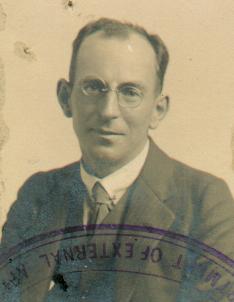
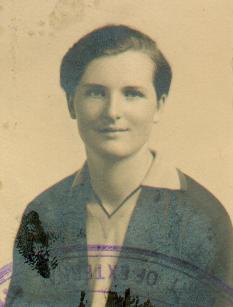
Dick Humphreys,
School at St.Enda's, 1909-1912:
Dick's widowed mother Nell sent him in 1909 to
Patrick Pearse's
radical school,
St. Enda's,
Cullenswood House, Oakley Road,
Ranelagh [founded Sept 1908].
Thomas MacDonagh
taught there.
Con Colbert
was a drill instructor.
Dick entered in the second intake, as day boy in the Senior School, 7 Sept 1909 [age 13].
See
[An Macaomh, Christmas 1909, p.56].
He
had to travel to Ranelagh from
Northumberland Rd.
He loved it.
St. Enda's moved 1910 to The Hermitage, Grange Rd, Rathfarnham,
an 18th century building.
See [Irish Country Houses].
It was
too far to travel as day boy to Rathfarnham from Northumberland Rd,
so Dick entered The Hermitage as a boarder, 12 Sept 1910 [age 14].
See extract
from [An Macaomh, Christmas 1910].
Dick
("Risteard Mac Amhlaoibh")
is
listed
as a boarder
in
St. Enda's, Rathfarnham, in
[Census, 2 April 1911].
His diary in early 1912
(age 15-16) at St.Enda's
(also in
[Mac Eoin, 1980])
shows that he had his own rifle
and was being trained in shooting.
The diary shows he was already driving a motor car in 1912.
He had an early interest in motoring.
Went on lot of cycle trips.
Saved up to buy a motorcycle.
See letter from Pearse to Nell, June 1912
as she considers taking him out of the school.
Pearse says:
"I hope we may count on welcoming Dick back to St. Enda's in September?
His last word to me was not to fail to write to you on this point.
We have threshed out the matter at length before,
so there is no use in bothering you with further arguments,
but I do most sincerely hope that you have decided
to leave him with us until he has completed
his secondary course".
School at Clongowes, 1912-1914:
Dick was taken out of St. Enda's
and sent to Clongowes, Co.Kildare,
Sept 1912 [age 16].
Was
left at railway station (must be in Co.Kildare).
He ran away,
hiked over Dublin Mountains, on Co.Kildare/Co.Wicklow/Co.Dublin border,
and went not home to Northumberland Rd,
but rather back to St.Enda's.
Dick said (reference lost):
"I descended on my old Alma Mater like a poor relation after a 3 day, intensely cold,
and equally lonely bivouac in the Dublin Mountains ... My aim was to get back to Scoil Eanna
from which I had been removed at the behest of certain rather pro-British friends of my mother
who believed in a more 'practical' form of education than that offered by the Pearse family".
See also 1966 interview.
See
letter he wrote to his mother from St.Enda's
on 2 Sept 1912:
"Dear Mama,
Did you really think that I was going to Clongowes like that, no I couldn't do it not if you offered me a motor cycle."
But Nell would not back down.
He was sent back to Clongowes.
In Clongowes 1912-1914.
See
further letter from Pearse to Nell
in Jan 1913.
Dick became a
member of the Irish Volunteers
(founded by
his uncle The O'Rahilly 1913).
He
was with The O'Rahilly
at Howth gun-running
(which The O'Rahilly organised), 26 July 1914, age 18 yrs.
Dick left school 1914.
Entered
UCD, Arts, 1914.
His mother Nell went in to the GPO, persuaded him to come home Tue night.
Pearse said to Dick:
"You had better go home. If anything happens your uncle, there will be no man there."
Dick and Nell were nearly killed going home
when passing
Boland's Mill,
where a jittery rebel took a shot at them.
Dick complained that he was perfectly safe in the GPO.
See Sighle's account
in
[Mac Eoin, 1980]
and
[P106/976]
and
interview.
See
[O'Rahilly, 1991, p.211].
Dick came home to make his mother happy, but he went back on Wed.
And on Wed it became too dangerous to leave the GPO.
On Friday 28 Apr 1916,
he writes in
[1916 memoir, revised version],
with the GPO in flames,
"O'Rahilly again appears, comes over, and tells me to join
Desmond Fitzgerald
down in the restaurant. The GPO is about to be evacuated.
With a cheerful wave of his hand, and a smile, he steps quickly down the smoke-filled stairs.
Little did I know that this was the last time I was ever to see him alive".
The O'Rahilly was shot on Moore St later Fri night.
Dick stayed to the end with the main garrison in the GPO.
They surrendered Sat afternoon, 29 Apr 1916.
(Family story that he got down as far as Trinity College before capture.)
[1916 memoir]
shows he was processed at the Rotunda Hospital,
then in Dublin Castle.
Then put in Kilmainham Gaol.
From his cell
he heard the executions,
which started on 3 May.
Prison in Britain, 1916:
On Fri 5 May 1916,
he and many other rebels were taken to
Richmond Barracks
for deportation to Britain.
"Richard Humphreys, 54 Northumberland Rd"
was among those deported to Britain from Dublin docks on a
LNWR
cattle boat,
Fri night, 5 May 1916.
After a brutal crossing, they arrived at
Holyhead
in the small hours of Sat.
Taken by train to
Wakefield Military Detention Prison,
Yorkshire, arriving evening of Sat 6 May.
[Aodogán]
said
Nell went to morgue, told both her brother and her son were dead,
would need 2 coffins.
It was some days before family found out he was still alive.
Nell made a big fuss about his youth to get him released, gave impression he was only about 16,
"of course it was just propaganda"
[Aodogán].
Jailed at Wakefield for 3 weeks (i.e. until end of May).
[1916 memoir]
says his cell at Wakefield was Cell 15, B Wing, Gallery no.4 (top floor).
See photos of Wakefield
around 1916.
The rebels were moved from Wakefield to
Frongoch camp in Wales,
starting
around the end of May.
The end of
[1916 memoir]
suggests Dick was released at this point
and did not go to Frongoch.
The papers in
[P106]
show his release was considered imminent in early June 1916.
See letter of 1 June 1916.
He was released before the start of Michaelmas term
(Sept or Oct) 1916, when he enrolled as a law student at the King's Inns.
When he came back
his family asked him what prison was like. He said:
"Not bad - it was much better than Clongowes!"
Revolutionary in 1919-1921:
Like the rest of his family, he continued as a nationalist revolutionary.
Desmond Fitzgerald wrote
7 Jan 1919
from Gloucester Prison
to "Mr. Humphreys",
thanking
his election workers in Pembroke
(Dick's family)
after his election as a Sinn Fein MP.
This letter was for sale
in 2009
at
Whyte's.
In
War of Independence 1919-1921,
Dick was in
B Company, 3rd Battalion, Dublin Brigade
IRA.
He started regular
motoring journalism.
He wrote for The Irish Cyclist and Motor Cyclist,
mainly 1919-1922.
Mainly under the pen name "Ricardo".
Also
'Armfrees' and 'Amfrees'.
Dick and his sister
Sighle
studied in Paris
in late 1919 - early 1920.
They were both at
University of Paris.
Arrest and jail, 1920:
There was a
raid of their house, 14 Herbert Park, by British on Easter Saturday, 3 Apr 1920.
Dick arrested.
Moved to Mountjoy
on 4 Apr 1920.
Went on hunger strike with other prisoners, for 10 days.
He was
freed on 14 Apr 1920.
See
account in
[P106/563]
and
Sighle's diary
[P106/908].
He
took part in
motorcycle and motor sport
from at least June 1920 to 1927.
Hunger strike
injured his health.
Went down country to recover.
He
stayed in his granduncle John Mangan's
house Gourbane, Shanagolden, Co.Limerick.
He was there
when Shanagolden was attacked
by the Black and Tans, Aug 1920.
Dick
studied law at the Four Courts,
called to bar Nov 1920 (BL), but never practiced.
Tommy O'Brien
said Dick was going to be a
barrister, but could not bring himself
to practice in the Free State courts.
Denis Mangan
said Dick would not take the oath to the crown
which still had to be taken.
Arrest and jail, 1921:
British raid on Ailesbury Rd
Easter 1921 (apparently Easter Sunday, 27 Mar 1921).
Dick arrested.
He was studying law at time, decided to fight case,
they couldn't prove theirs, acquitted,
but he was finished with the IRA for recognising the court.
[Lavelle, 1961]
says he was in prison Apr 1921.
He rode in the
Isle of Man TT, June 1921.
He came 5th in the Lightweight 250 cc class.
He was
on committee of Dublin & District Motorcycle Club 1922.
See their 1922 programme.
He did the artwork on D & D posters and programmes.
Unlike his siblings, he
took no part in Civil War (1922-23).
He
went into business end-1922,
as "O'Mara Rubber Co", based
at 79 Dame St, Dublin,
agreement dated 9 Oct 1922.
The rest of the family was jailed after
Free State raid on Ailesbury Rd in the Civil War, Nov 1922.
Dick was arrested but soon released.
He was not imprisoned in the Civil War.
In Feb 1923
[P106/396]
when most of the family except Dick were in jail,
a party of Free State soldiers threw a hand grenade into the hall of
Ailesbury Rd, only caused minor damage.
This would be the episode remembered in [Nell's obituary]
where
"the Free Staters tried to burn down Ailesbury Road, but were unsuccessful".
[P102/543]
says
"A mine was placed in the hall but fortunately only the staircase and some of the furniture were damaged.".
Dick's family were all released from prison by end of 1923.
The "Thomond" motor car:
On the 1926 "24 hours" trial he saw his friend
James A. Jones'
home-built
Thomond motor car
in action
(this was Thomond no.1).
From 1928 he designed and with Jones built his own car,
Thomond no.2, finished 1929.
These were first cars built in Irish Free State.
He
moved his motor business to
36 Pearse St, Dublin
probably 1928.
Name of business changed not long after to
"Humphreys Autofactors".
Dick dies, 1968:
He died Fri 20 Sept 1968, Mater Hospital, Dublin, age 72 yrs.
See mass card.
See
death notice
in Irish Times,
21 Sept 1968.
Funeral 21 Sept 1968,
bur Saggart, Co.Dublin.
Eamon de Valera, then President of Ireland,
went to his funeral.
Eithne lived at
Kingswood
for many years.
Eithne dies, 1995:
She died 10 am, Tue 10 Jan 1995, Mount Carmel Hospital, Dublin, age 86 yrs.
See death notice
in Irish Times,
January 11, 1995.
Funeral Thur 12 Jan 1995.
Her nephew Fr. James Lavelle
said it.
She was
bur Saggart, Co.Dublin.
The family eventually left Kingswood.
See
Kingswood after Humphreys.
Dick and Eithne had issue:



Dick is deported to prison in England.
Irish Times,
May 14, 1916.
See also
Dublin Evening Mail, 13th May 1916.
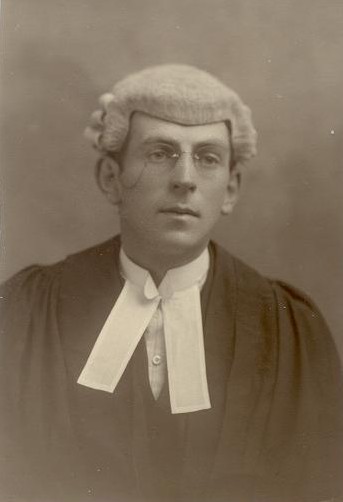
Dick when called to bar, 1920.
See BMP format
and TIF format.
See copy
in
[P106/594].
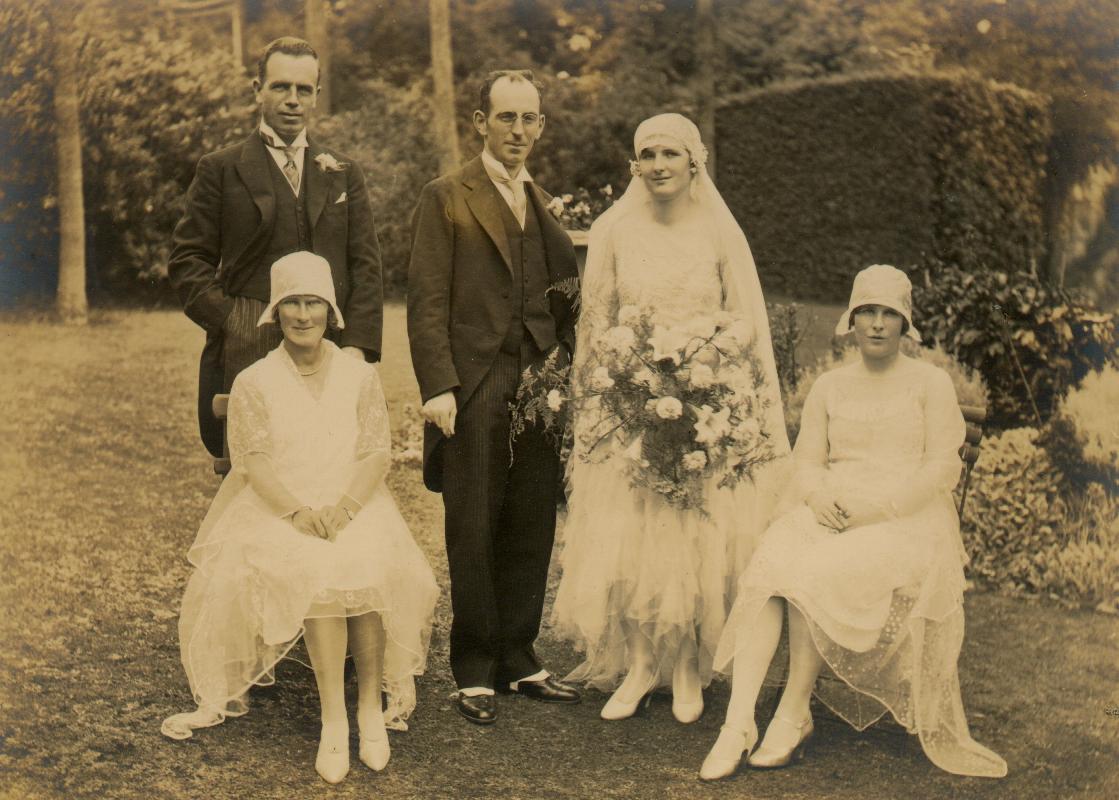
Dick and Eithne's wedding, 1929.
This image has, amazingly,
been used since 2007 on Wikipedia
as a core photo for wedding-related articles.
See The story of Granny's photo and Wikipedia.
See full size.
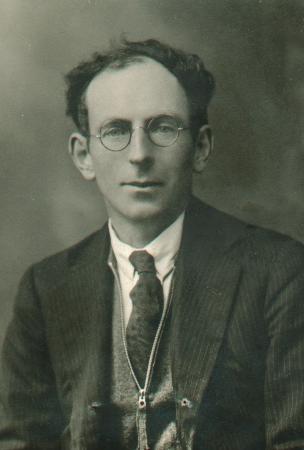
Dick Humphreys.
2016 video
by
Alannah Humphreys
about her great-grandfather Dick Humphreys.
She also wrote an article:
"The 1916 Rising from the perspective of Richard Humphreys",
Alannah Humphreys,
in
The Kinsale Record
(The Journal of the Kinsale and District Local Historical Society), vol. 25, 2017.
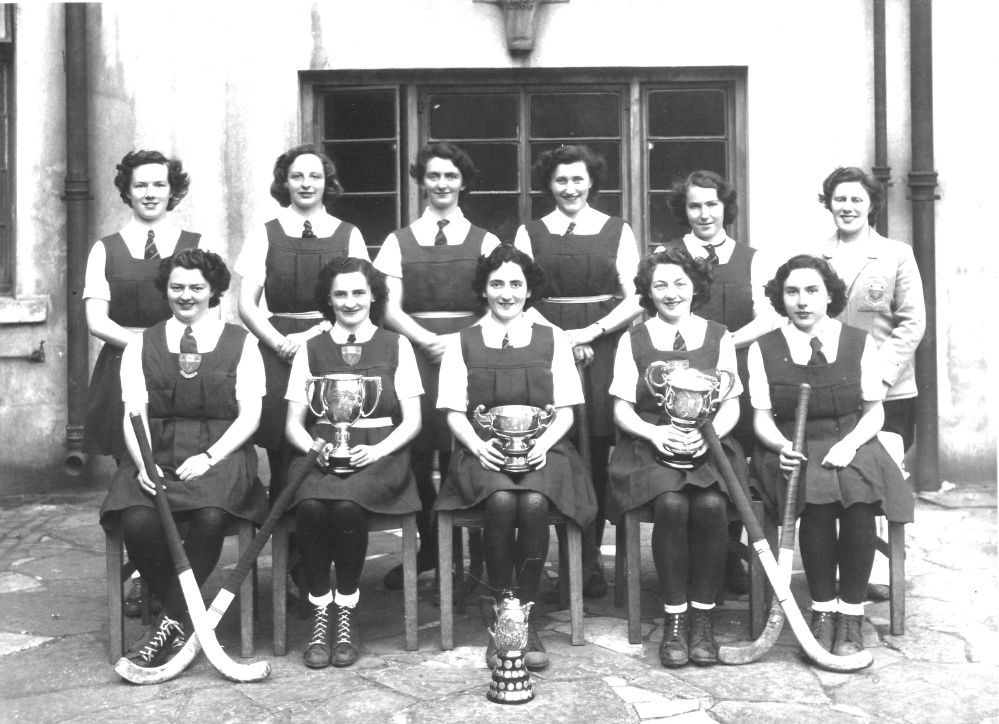
Eoige (back row, 2nd from RHS) on
UCD Hockey team, 1950-1951.
Back: C. Bolger (Architecture), B.Kelly (Commerce), U.O'Cleary B.A. (Social Science);
J.Liston (Soc.Sci); E. Humphreys (Arts); P. Fay (B.Comm).
Front: Dr.McKenzie, M.Madigan (Commerce); P.Horne (2nd Med, Captain), Dr.MacHale, K.O'Riordan (Arts).
See full size.


"I wasn't actually in Moore St. And I heard of my uncle's death only 2 days later when I was in the Castle. A Tommy mentioned about one of the leaders, O'Rahilly, being killed. And it was a frightful shock because I knew they'd got out alright. I didn't know that any of them had been killed at the time."
- Dick hears about the death of his uncle The O'Rahilly in the 1916 Rising.
From
1966 interview.
"England has triumphed once again, but ... this fight has shaken her as she has never
been shaken before. Next time the whole country, and not Dublin alone will join the fray."
- The ending of
Dick's memoir of 1916,
as published in
[Jeffery, 2006].
I had thought this was a remarkable prophecy made by Dick at the time,
but it does not appear in the original in
The Belvederian, 1917.
Unfortunately, it is an addition made by Dick to his memoir later.
Please donate to support this site.
I have spent a great deal of time and money on this research.
Research involves travel and many expenses.
Some research "things to do"
are not done for years, because I do not have the money to do them.
Please Donate Here
to support the ongoing research and
to keep this website free.